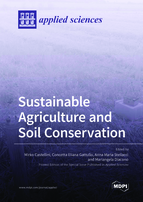Sustainable Agriculture and Soil Conservation
A special issue of Applied Sciences (ISSN 2076-3417). This special issue belongs to the section "Environmental Sciences".
Deadline for manuscript submissions: closed (31 December 2020) | Viewed by 44386
Special Issue Editors
Interests: soil hydrology; soil conservation
Special Issues, Collections and Topics in MDPI journals
Interests: precision agriculture; linear mixed effects models; spatial and temporal residual autocorrelation; sustainable agronomic management; soil physical quality indicators and soil quality indices computation
Special Issues, Collections and Topics in MDPI journals
Interests: soil hydraulic conductivity; soil water retention; soil physical quality; soil management; soil conditioners
Special Issues, Collections and Topics in MDPI journals
Interests: organic farming; agro-ecology; compost production, evaluation and application; sustainable agriculture assessment
Special Issues, Collections and Topics in MDPI journals
Special Issue Information
Dear Colleagues,
Soil degradation is one of the most topical environmental threats. A number of processes causing soil degradation, specifically erosion, compaction, salinization, pollution, and loss of both organic matter and soil biodiversity, is also strictly connected to agricultural activity and its intensification. The development and adoption of sustainable agronomic practices able to preserve and enhance the physical, chemical, and biological properties of soils and improve agroecosystem function is a challenge for both scientists and farmers. In recent decades, much progress has been achieved in the development of sustainable practices based on minimal soil disturbance, use of cover crops, organic mulching, crop rotations, water and nutrients conservation, recycling of crop residues and livestock manure for soil amendment, and precision agriculture. Several natural mechanisms of plants and microorganisms have also been usefully applied for the control of weeds and pests, as well as for the abatement of soil pollution. Furthermore, collaboration among different scientific disciplines has increased the ability to investigate problems and find practical solutions. In particular, the availability of innovative methodologies for rapid and accurate soil–plant system monitoring (proximal sensors, expeditious methods) and for data analysis has improved the understanding of soil processes and the adoption of sustainable management options. In addition, the sustainability assessment of agricultural systems performed by different methodologies, such as energy analysis and carbon footprint evaluation, is a crucial step in facing environmental threats like greenhouse gas (GHG) emission that lead to global warming.
This Special Issue welcomes original research papers and reviews focusing on recent advances and novelties in the field of sustainable and conservative agriculture. Multidisciplinary investigations are strongly encouraged.
Dr. Concetta Eliana Gattullo
Dr. Anna Maria Stellacci
Dr. Mirko Castellini
Dr. Mariangela Diacono
Guest editors
Manuscript Submission Information
Manuscripts should be submitted online at www.mdpi.com by registering and logging in to this website. Once you are registered, click here to go to the submission form. Manuscripts can be submitted until the deadline. All submissions that pass pre-check are peer-reviewed. Accepted papers will be published continuously in the journal (as soon as accepted) and will be listed together on the special issue website. Research articles, review articles as well as short communications are invited. For planned papers, a title and short abstract (about 100 words) can be sent to the Editorial Office for announcement on this website.
Submitted manuscripts should not have been published previously, nor be under consideration for publication elsewhere (except conference proceedings papers). All manuscripts are thoroughly refereed through a single-blind peer-review process. A guide for authors and other relevant information for submission of manuscripts is available on the Instructions for Authors page. Applied Sciences is an international peer-reviewed open access semimonthly journal published by MDPI.
Please visit the Instructions for Authors page before submitting a manuscript. The Article Processing Charge (APC) for publication in this open access journal is 2400 CHF (Swiss Francs). Submitted papers should be well formatted and use good English. Authors may use MDPI's English editing service prior to publication or during author revisions.
Keywords
- Soil fertility and nutrient cycling
- Carbon sequestration
- Soil degradation
- Cover crops
- Soil biodiversity
- Soil pollution and remediation
- Water conservation practices
- Soil monitoring and characterization
- Proximal sensing for precision input applications
- Sustainability assessment









